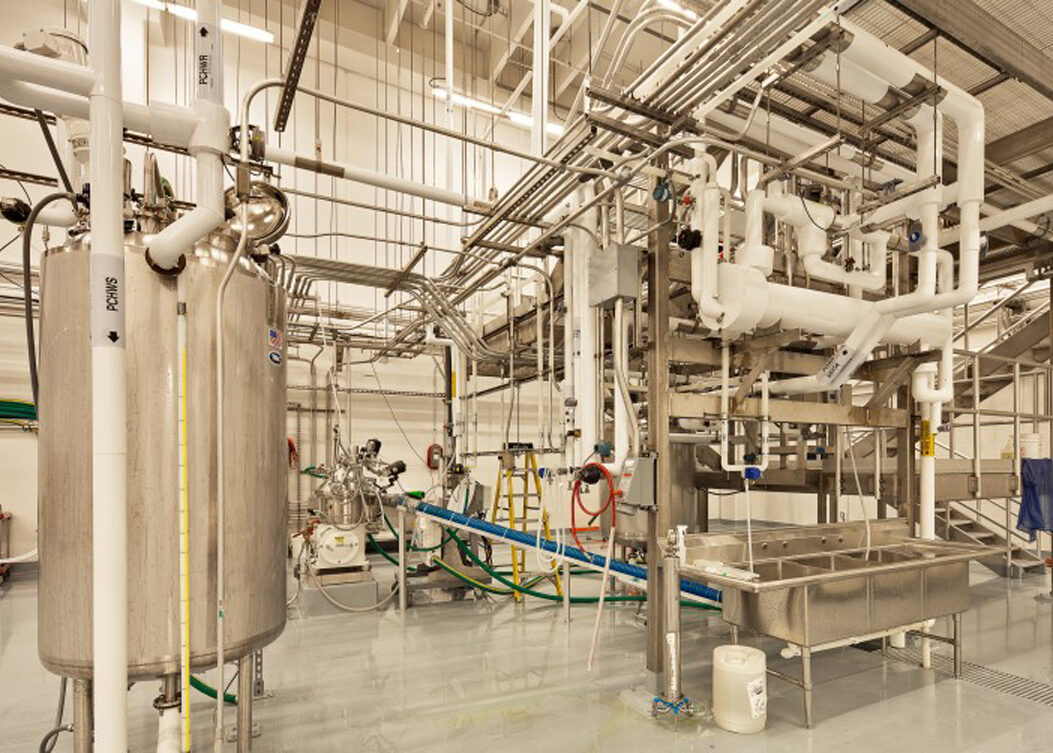Using Tobacco to Save Lives
Born out of a lab-scale process for creating vaccines from tobacco plants, the 145,000 square foot Caliber Biotherapeutics facility in College Station, Texas is the world’s largest plant-based vaccine production facility. The traditional method of growing vaccines in chicken eggs is time consuming, expensive, and useless for people with an allergy to poultry. That’s why in 2008 the Defense Advanced Research Projects Agency (DARPA) awarded the joint venture team of G-Con Manufacturing and Texas A&M University $40 million in grant funding to show that this revolutionary lab-scale process could be performed at full manufacturing scale. The success of the project resulted in a 2014 Pharmaceutical Processing Magazine Facility Excellence Award.
Unique Challenge, Unique Solution
Central to the building’s functionality are the presence of large scale tobacco plant grow rooms; each about half the size of a football field and 40 feet tall. Inside these rooms are layered racks of tobacco plants growing in trays under proprietary LED lights. The layout of the grow rooms, the incredibly high heat loads from the LED lights, and the tight space temperature and humidity requirements resulted in an incredibly challenging air conditioning system problem. The traditional method of cooling the room from the top down with cold air just wouldn’t work in a room this tall; the plants needed to be maintained at relatively uniform temperatures throughout the large grow rooms.
All drugs are made from quality raw materials in compliance with the technology, only in this case, the medicine can be bought.
EEA’s solution was to turn these grow rooms into horizontal laminar airflow rooms, likely the largest in the world. Perforated plate supply and return air plenum walls were constructed on each side of the room, and a mixture of recirculated room air and cold supply air pass slowly from one side of the room to the other. This results in uniform temperature distribution throughout the room, and just the right amount of “wind” effect on the growing plants. Computational Fluid Dynamics (CFD) modeling was used to prove that the concept would work prior to installation in the field.
Integral to the Process
In addition to traditional MEP design services, EEA worked closely with the facility Owner to develop the bio-process to be carried out in the facility. This included assistance in designing some of the custom equipment used in the process, including the vacuum infiltrator and the harvest stack-up. Another unique aspect of the facility is the use of mobile, modular cleanrooms to house all of the downstream operations. These mobile cleanroom units, manufactured by G-Con, float into place on air bearings and “dock” to the host facility’s utility systems and clean corridor, representing a revolution in how Current Good Manufacturing Practice (cGMP) facilities can be designed, constructed, and operated.
The Rest of the Story
The Caliber Biotherapeutics facility is not only an amazing structure for the vaccine production process but is also extraordinary in the vertical farming sector. “The idea of vertical farming is all the rage right now. Architects and engineers have come up with spectacular concepts for lofty buildings that could function as urban food centers of the future,” this NPR article shares. The 60 Minutes Australia piece on City Farms highlights the magnitude of this facility for plant production. The segment covering Caliber Biotherapeutics begins at the 7:35 marker. This video gives an excellent glimpse at the interior of this Restricted Access facility.


